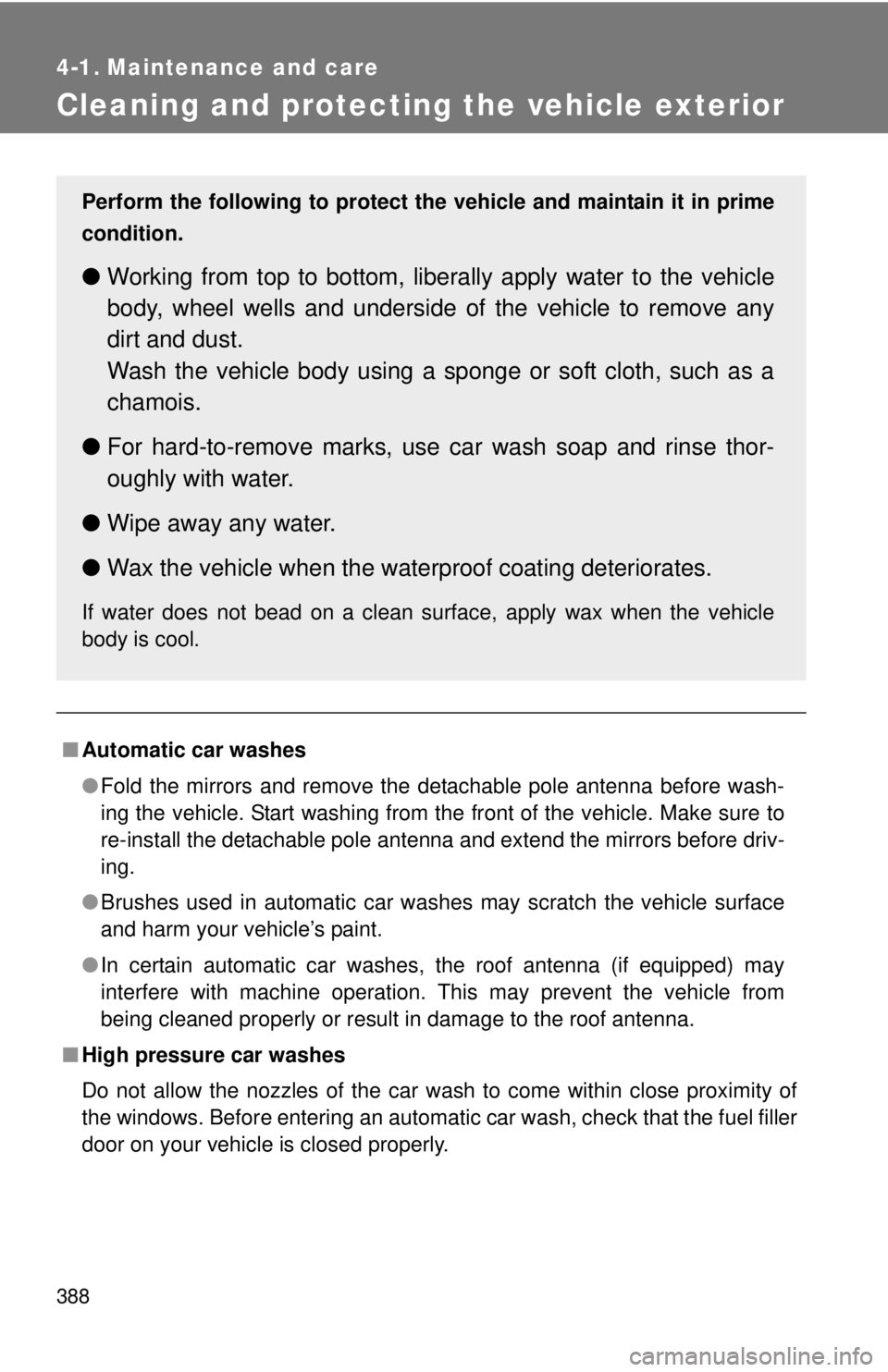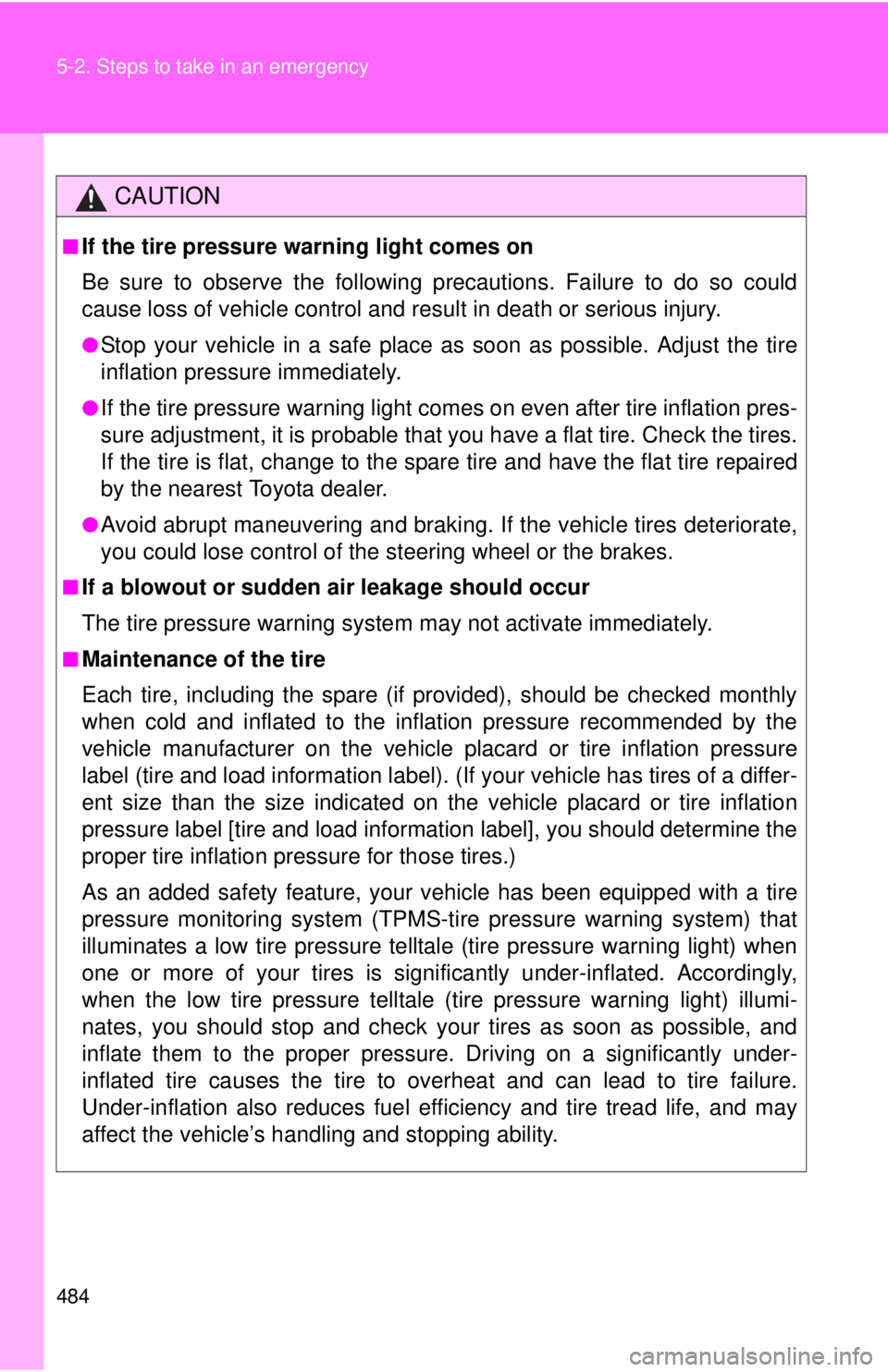Page 7 of 590
7
Tires
●Rotation
● Replacement
● Inflation pressure
● Information
P. 422
P. 486
P. 431
P. 540
Fuel filler door P. 74
Rear turn signal
lights
P. 141
Rear side marker lightsP. 152
Side doors P. 35
: If equipped
Stop/tail lightsP. 152
TailgateP. 40
License plate lights P. 152
Access doors P. 39
Page 9 of 590
9
Tires
●Rotation
● Replacement
● Inflation pressure
● Information
P. 422
P. 486
P. 431
P. 540
Fuel filler door P. 74Rear turn signal
lights
P. 141
Rear side marker lightsP. 152
Side doors P. 35
: If equipped
Stop/tail lightsP. 152
TailgateP. 40
License plate lights P. 152
Page 388 of 590

388
4-1. Maintenance and care
Cleaning and protecting the vehicle exterior
■Automatic car washes
●Fold the mirrors and remove the detachable pole antenna before wash-
ing the vehicle. Start washing from the front of the vehicle. Make sure to
re-install the detachable pole antenna and extend the mirrors before driv-
ing.
● Brushes used in automatic car washes may scratch the vehicle surface
and harm your vehicle’s paint.
● In certain automatic car washes, the roof antenna (if equipped) may
interfere with machine operation. This may prevent the vehicle from
being cleaned properly or result in damage to the roof antenna.
■ High pressure car washes
Do not allow the nozzles of the car wash to come within close proximity \
of
the windows. Before entering an automatic car wash, check that the fuel filler
door on your vehicle is closed properly.
Perform the following to protect the vehicle and maintain it in prime
condition.
● Working from top to bottom, liber ally apply water to the vehicle
body, wheel wells and underside of the vehicle to remove any
dirt and dust.
Wash the vehicle body using a sponge or soft cloth, such as a
chamois.
● For hard-to-remove marks, use car wash soap and rinse thor-
oughly with water.
● Wipe away any water.
● Wax the vehicle when the waterproof coating deteriorates.
If water does not bead on a clean surface, apply wax when the vehicle
body is cool.
Page 434 of 590

434 4-3. Do-it-yourself maintenance
■Tire inflation pressure check interval
You should check tire pressure every two weeks, or at least once a
month.
Do not forget to check the spare.
■Effects of incorrect tire inflation pressure
Driving with incorrect tire inflation pressure ma y result in the following:
●Reduced fuel efficiency
●Reduced driving comfort and tire life
●Reduced safety
●Damage to the drive train
If a tire needs frequent re filling, have it checked by your Toyota dealer.
■Instructions for checking tire inflation pressure
When checking tire inflation pressure, observe the following:
●Check only when the tires are cold.
If your vehicle has been parked for at least 3 hours and has not been
driven for more than 1 mile or 1.5 km, you will get an accurate cold
tire inflation pressure reading.
●Always use a tire pressure gauge.
The appearance of the tire can be mi sleading. In addition, tire infla-
tion pressures that are even just a few pounds off can degrade ride
and handling.
●Do not bleed or reduce tire inflation pressure after driving. It is normal
for the tire inflation pressure to be higher after driving.
●Never exceed the vehicle capacity weight.
Passengers and luggage weight should be placed so that the vehicle
is balanced.
Page 452 of 590

452 4-3. Do-it-yourself maintenance
7 IG1 NO.210 AAnti-lock brake system, vehicle sta-
bility control system, stop lights,
charging system, multiport fuel
injection system/sequential multi-
port fuel injection system, air condi-
tioning system, instrument panel
light control, anti-glare inside rear
view mirror, back monitor, clutch
start cancel switch, rear differential
lock system, power outlets, tire
pressure warning system
8 BKUP LP 10 A Trailer lights (back-up lights)
9 IG1 10 AAnti-lock brake system, traction
control system, vehicle stability
control system, back-up lights, air
conditioning system, shift lock sys-
tem, audio system
10 P RR P/W 20 ARear passenger’s power window
(right side)
11 P FR P/W 20 A Front passenger’s power window
12 WSH 10 A Wipers and washer
13 D RR P/W 20 ARear passenger’s power window
(left side)
14 4WD 20 AFour-wheel drive system, rear dif-
ferential lock system
15 WIP 30 A Wipers and washer
16 D FR P/W 30 A Power windows
FuseAmpereCircuit
Page 480 of 590
480 5-2. Steps to take in an emergency
Tire pressure warning
light
When the light comes on:
Low tire inflation pressure
such as
• Natural causes ( P. 482)
• Flat tire ( P. 486) Adjust the tire inflation
pressure to the speci-
fied level.
The light will turn off
after a few minutes.
In case the light
does not turn off
even if the tire infla-
tion pressure is
adjusted, have the
system checked by
your Toyota dealer.
• When the light stays on after blinking for 1
minute: Malfunction in
the tire pressure warning
system. ( P. 483) Have the system
checked by your
Toyota dealer.
Low fuel level warning
light
Low level of fuel. Refuel the vehicle.
Warning lightWarning light/DetailsCorrection procedure
Page 482 of 590

482 5-2. Steps to take in an emergency
■Key reminder buzzer
The buzzer indicates that the key has not been removed (with the engine
switch in the ACC or LOCK position and the driver’s door opened).
■ If the malfunction indicator lamp comes on while driving
First check the following:
● Is your vehicle low on gas?
If it is, refuel the vehicle immediately.
● Is the fuel tank cap loose?
If it is, tighten it securely.
The light will go off after taking several driving trips.
If the light does not go off even after several trips, contact your Toyota dealer
as soon as possible.
■ Front passenger detect ion sensor and passenger seat belt reminder
If luggage or other load is placed on the front passenger seat, depending on
its weight, the reminder light to flash and buzzer to sound.
■
When the tire pressure warning light comes on
Check the tire inflation pressure and adjust to the appropriate level.
Pushing the tire pressure warning reset switch does not turn off the tire
pressure warning light.
■The tire pressure warning light ma y turn on due to natural causes
The tire pressure warning light may turn on due to natural causes such
as natural air leaks or tire inflation pressure changes caused by temper-
ature. In this case, adjusting the ti re inflation pressure will turn off the
warning light (after a few minutes).
■When a tire is replaced with a spare tire
The temporary spare tire is not equipped with the tire pressure warning
valve and transmitter. If a tire goes flat, the tire pressure warning light will
not turn off even though the flat tire is replaced with the temporary spare
tire. Replace the temporary spare tire with the repaired tire and adjust
the proper tire inflatio n pressure. The tire pres sure warning light will turn
off after a few minutes.
Page 484 of 590

484 5-2. Steps to take in an emergency
CAUTION
■If the tire pressure warning light comes on
Be sure to observe the following precautions. Failure to do so could
cause loss of vehicle control and re sult in death or serious injury.
●Stop your vehicle in a safe place as soon as possible. Adjust the tire
inflation pressure immediately.
●If the tire pressure warning light comes on even after tire inflation pres-
sure adjustment, it is pr obable that you have a flat tire. Check the tires.
If the tire is flat, change to the spare tire and have the flat tire repaired
by the nearest Toyota dealer.
●Avoid abrupt maneuvering and braking. If the vehicle tires deteriorate,
you could lose control of the steering wheel or the brakes.
■If a blowout or sudden air leakage should occur
The tire pressure warning syste m may not activate immediately.
■Maintenance of the tire
Each tire, including the spare (if provided), should be checked monthly
when cold and inflated to the inflation pressure recommended by the
vehicle manufacturer on the vehicle placard or tire inflation pressure
label (tire and load information label). (If your vehicle has tires of a differ-
ent size than the size indicated on the vehicle placard or tire inflation
pressure label [tire and load information label], you should determine the
proper tire inflation pr essure for those tires.)
As an added safety feature, your vehicle has been equipped with a tire
pressure monitoring system (TPMS-ti re pressure warning system) that
illuminates a low tire pressure telltal e (tire pressure warning light) when
one or more of your tires is significantly under-inflated. Accordingly,
when the low tire pressu re telltale (tire pressure warning light) illumi-
nates, you should stop and check your tires as soon as possible, and
inflate them to the proper pressure. Driving on a significantly under-
inflated tire causes the tire to overheat and can lead to tire failure.
Under-inflation also reduces fuel effi ciency and tire tread life, and may
affect the vehicle’s handling and stopping ability.